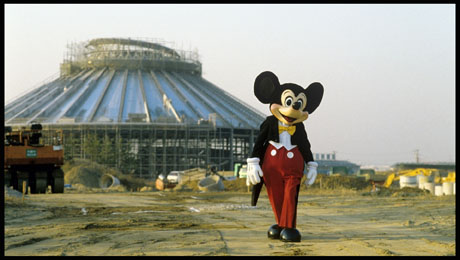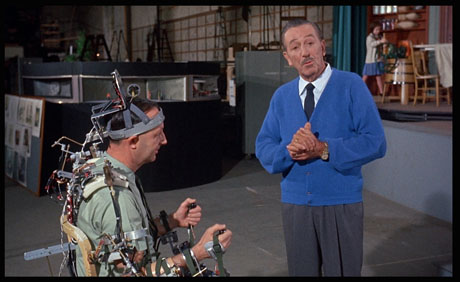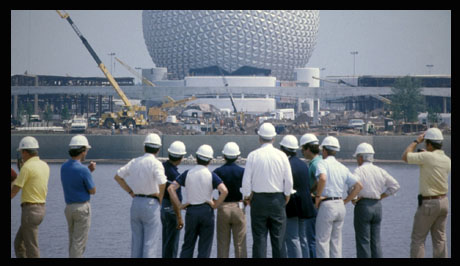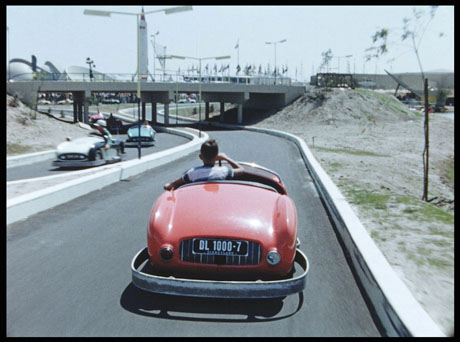
Animation enthusiasts will immediately recognize the last name. Leslie Iwerks is the granddaughter of the tectonically influential Ub Iwerks, Walt Disney’s Oscar-winning early studio partner who singlehandedly animated Steamboat Willie, Oswald the Lucky Rabbit cartoons and developed a myriad of technological advances that continue to enhance entertainment. Documentarian Leslie Iwerks’ path is to shed light on accomplished as well as those whose every day is a struggle to survive. In the latter effort, she received an Academy Award nomination for the feature doc, Recycled Life.
But it was her feature The Pixar Story that inspired Walt Disney Imagineering Legend Marty Sklar to ask her to chronicle the journey of what began as WED Enterprises. Under Walt Disney’s leadership, it’s a conduit to every Disney attraction and resort worldwide. The Imagineering Story, a six-hour series, debuts on Disney+ this week, streaming a new slate of original programming as well as films from Disney, Pixar, Marvel and Lucas libraries.

Just the trailer for The Imagineering Story simmers with the promise of unearthed footage and fascinating peeks into nooks and crannies of “backstage” areas either rarely or never seen. It’s a throwback of sorts to programs Walt Disney personally presented, in which he eagerly revealed his film and park projects (for example, he had no problem showing the world the Audio-Animatronics shell of Abraham Lincoln without his “skin”) His enthusiasm was not only verifiably genuine, but he knew that the more he took viewers behind the curtain—at least to the very edge of spoiling the magicians’ magic—the more he intensified a viewer’s anticipation to experience each project in person.
GREG EHRBAR: You were granted an enormous amount of access into tunnels, and the Utilidor. This is a very exciting thing.

Leslie Iwerks
EHRBAR: All too often, behind-the-scenes specials, entertainment shows and bonus features can get pretty fluffy and P.R. heavy. There’s an assumption that no one at home will “get it” or want to dig very deep. But this series seems more detailed about a lot of things.
IWERKS: Yeah, it’s pretty deep. We could have gone even deeper, but you only have so much time. I never wanted to do a puff piece. I wanted this to be a true, objective look at the trials, the tribulations, the pitfalls and the lessons learned.
EHRBAR: How was the filming done over the five years of production?
IWERKS: We traveled to all the Parks around the world, documenting behind the scenes and interviewing people. We really weren’t sure at the time what the final film was going to be, but we thought it could be a ninety-minute film. I was also working on other films so we might go in July for two weeks to shoot in Orlando and then in September, film in Anaheim for the opening of something. Whatever it was. It was all just bits and pieces throughout the years and then the editing started at the very end. But I would really maximize what we had in our budget to film and try to get more people into the queue, so to speak, to be interviewed, to make sure I chronicled the whole history as best I could, to document the people who were getting older… and that worked out well. When all was said and done, we did over 250 individual interviews.

EHRBAR: And because of the ability to make this a six-hour Disney+ series, it was no longer restricted to feature film length. What are some of the surprises you discovered?
IWERKS: The fact that we were able to find images and footage. We dusted off old film cans that no one’s ever seen before. Visually, our priority was to get as much footage as possible that has never been seen, even though that’s really tough for the Disneyland years. But we did find quite a bit of stuff. That was our goal, to make sure the fans saw new footage. We also pulled audio sound bites from the original Imagineers that no one has never heard. We went back through transcripts in The Walt Disney Archives and wove those in, so the voices of the Imagineers are throughout the whole film. Walt’s voice permeates the whole film too–kind of the rock that reminds us of what his vision was, what his mistakes were, to bring his human story to it, his voice to it.
EHRBAR: Many prominent names in Disney history are represented of course, but I understand you also include some unsung heroes who have never really been given their due.
IWERKS: I think some of the critical interviews that people haven’t seen are from Frank Stanek and Carl Bongirno, who were at the studio in those days of the ’70s and ’80s. Carl Bongirno’s story is little known. He was basically in charge of finance for WED at the time when WED was pretty much on the chopping block, after Card Walker resigned and pre-Michael and Frank coming in. Carl was very instrumental in saving WED. That, to me, was a story that you don’t hear very often. I was very glad to be able to share that, to get his story. He’s ninety-something now, the most wonderful guy. Frank Stanek also provided a lot of the nuts and bolts and details about what was going on from a business standpoint within WED during those critical years.
EHRBAR: That’s an important aspect. Telling a story of people and events. Imagineering is a world of wonder and excitement, especially viewed from the outside, but there have been lean times as well as gravy times. Is that covered in the documentary?

IWERKS: Yeah, definitely. We structured this documentary in three layers. The first layer is the Imagineers and the goals that they have to achieve, the tasks that they set out to do, the ideas they have to pitch. What is the Imagineering story from the ground level?
And then the second layer is the administration above them—the executives and the management of the Walt Disney Company and, depending on leadership, how that impacts Imagineering–for good or for worse. Saying, “The finances aren’t good, so we’re pulling back,” versus saying, “I totally love everything you’re doing, just go for it. Just create and no holds barred. You have plenty of money, just go.” Kind of like Walt’s original ways in which he built Disneyland. It was like, “Just build it,” even though poor Roy had to deal with how to finance it.
The third layer is the overall–the economics in the world, other physical factors that took place that affected the Imagineers that would restrict or inspire them or push them forward. So there were three big layers that we looked at that weave the story together.
EHRBAR: This is a great thing because, at least outside of the reputable books about Disney, this is the probably first time the viewing public will see how circumstances can dictate what ends up in the parks. There are reasons behind every decision. That can also be a fascinating thing—the way the parks were built under each Disney leadership, the energy crisis, recession, all of those things affect what the parks—and can reflect them too.
IWERKS: I always felt like this was a hero’s journey. If you don’t have the mistakes and the failures along the way, you don’t have a hero. There were so many great moments, I should say in hindsight, we all collaborated together and got through and really, the film came out better as a result.
EHRBAR: That’s a major point there. That sort of thing is very, very rare.
IWERKS: It was, and I think it was really a testament to Bob Iger, who saw it and told me he learned things he never knew before and said he was really blown away by the history of it. It was cool that he was excited about it and learned things from it–and he didn’t say, “Oh, it’s got to be lighter.” He had his own notes as well, which I think were great.
EHRBAR: So for Disney to say “tell the story,” that must have seemed pretty bold.
IWERKS: The reality is that it’s a big testament to Disney to be so self-reflective in this piece. And to trust me, as the filmmaker, that I have Disney’s best interest in mind of course, and at the same time am going to be as honest and authentic as I can to bring up what others are telling me about the conflicts and what is already out there, but maybe has been buried over time—whether there were protests or criticisms, whatever the controversy was at the time that you could even see on Wikipedia. Why would we stray away from talking about it, because we’re only going to get criticized for it? I think it makes Disney that much stronger as a result for talking about its own lessons learned.
That’s exactly what we did with The Pixar Story, by the way. When John Lasseter, Steve Jobs and Ed Catmull hired me to do that film, that was a mantra early on. We want people to know how we failed because that’s how people are going to learn from our mistakes.

EHRBAR: It also corrects the information “ether,” filled with errors and hearsay.Iif you don’t tell the story the way it needs to be told, people are going to fill in the holes with incorrect information and that flies all over the place. It’s responsible to tell even the negatives as accurately as you possibly can the right way because you’ve got the resources and because you’re on the inside.
IWERKS: Right. And there’s some risk to that as well, as a filmmaker, because you are being critical. Surely there are going to be Imagineers who won’t be happy with me in certain things! (chuckle) But it’s not about criticizing people for something. You’re never going to be successful if you don’t try and fail. So much about Imagineering is learning from their failures—and they say that in there. If they’re not failing, they’re not doing their job. That’s a mantra for Imagineering and that’s what is super-cool about being able to talk about the stuff.
EHRBAR: That was Walt Disney’s philosophy, too.
IWERKS: Yeah. Look how experimental he was, that man. Incredible.
EHRBAR: He would repeatedly bet almost everything on big dreams. There are a lot of young people that will be watching this series. How much will they be seeing of Walt?
IWERKS: They’ll see a lot. He is throughout the whole show. His DNA and his voice runs through the whole thing. The truth is that the Imagineers are resting on the shoulders of those who came before, and those original Imagineers were resting on the shoulders of Walt, who was pushing and pushing them, inspiring them all the way.
I’ve documented a lot of companies, stories of innovation, driven by innovators and leaders. I don’t know of any company that is as deeply rooted in their everyday work as Disney, as Imagineering is to Walt Disney and as Disney Animation is to Walt Disney. He was just such a formidable figure in leadership that Disney is there every day in the lives of everybody. Of course now, with Disney+, he’s just so “there.” It’s just such a strong brand.
EHRBAR: All of your documentaries offer viewers something valuable to stay with them, long after they’ve watched.
IWERKS: There are so many issues I would love to tell. There are so many people with blinders on who just focus on their own lives without empathy to other issues in the world. my job is to create broader understanding.
EHRBAR: What do you hope people take away from The Imagineering Story?
IWERKS: Hopefully they’ll feel inspired. Ideally inspired to go create, or to experiment—to do things they never thought they could. Because that’s what this story is about.
[Leslie Iwerks’ documentaries include the aforementioned Recycled Life and The Pixar Story as well as The Hand Behind the Mouse: The Ub Iwerks Story; Ella Brennan: Commanding the Table; Citizen Hearst; Industrial Light & Magic: Creating the Impossible; Downstream (concerning the cancerous effects of oil sands on aboriginal communities in Alberta, Canada); Pipe Dreams (about the controversial Keystone XL pipeline) and Selling Lies (an exposé of a fake news operation). Information about these and other films can be found on the Iwerks & Co website. – Ed.]
- REVIEW: “Pencils Vs. Pixels” - November 6, 2023
- “Jellystone!” Creator C.H. Greenblatt: “This Show is a Love Letter” - July 21, 2021
- REVIEW: “The Puppetoon Movie 2” Blu-ray/DVD Set - February 3, 2021


 November 13th, 2019
November 13th, 2019  Greg Ehrbar
Greg Ehrbar  Posted in
Posted in  Tags:
Tags: 






